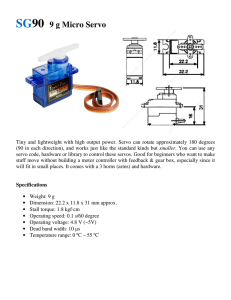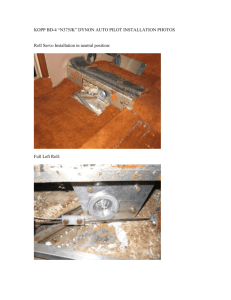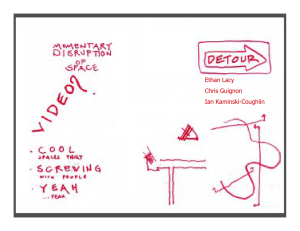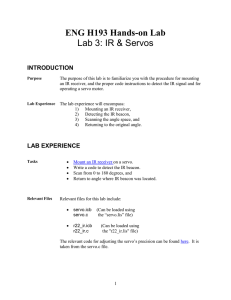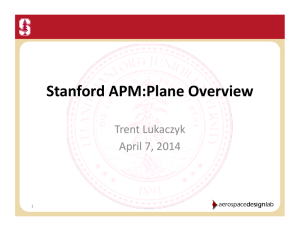GRT Servo Post-Installation Checkout Procedure This procedure is
advertisement
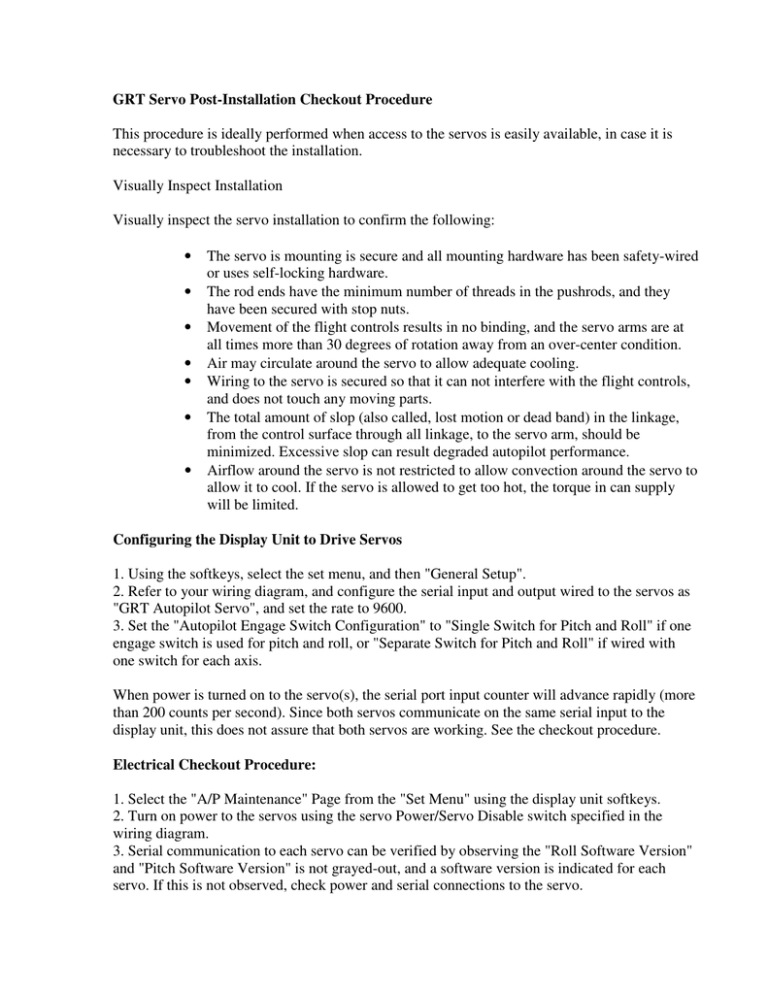
GRT Servo Post-Installation Checkout Procedure This procedure is ideally performed when access to the servos is easily available, in case it is necessary to troubleshoot the installation. Visually Inspect Installation Visually inspect the servo installation to confirm the following: • • • • • • • The servo is mounting is secure and all mounting hardware has been safety-wired or uses self-locking hardware. The rod ends have the minimum number of threads in the pushrods, and they have been secured with stop nuts. Movement of the flight controls results in no binding, and the servo arms are at all times more than 30 degrees of rotation away from an over-center condition. Air may circulate around the servo to allow adequate cooling. Wiring to the servo is secured so that it can not interfere with the flight controls, and does not touch any moving parts. The total amount of slop (also called, lost motion or dead band) in the linkage, from the control surface through all linkage, to the servo arm, should be minimized. Excessive slop can result degraded autopilot performance. Airflow around the servo is not restricted to allow convection around the servo to allow it to cool. If the servo is allowed to get too hot, the torque in can supply will be limited. Configuring the Display Unit to Drive Servos 1. Using the softkeys, select the set menu, and then "General Setup". 2. Refer to your wiring diagram, and configure the serial input and output wired to the servos as "GRT Autopilot Servo", and set the rate to 9600. 3. Set the "Autopilot Engage Switch Configuration" to "Single Switch for Pitch and Roll" if one engage switch is used for pitch and roll, or "Separate Switch for Pitch and Roll" if wired with one switch for each axis. When power is turned on to the servo(s), the serial port input counter will advance rapidly (more than 200 counts per second). Since both servos communicate on the same serial input to the display unit, this does not assure that both servos are working. See the checkout procedure. Electrical Checkout Procedure: 1. Select the "A/P Maintenance" Page from the "Set Menu" using the display unit softkeys. 2. Turn on power to the servos using the servo Power/Servo Disable switch specified in the wiring diagram. 3. Serial communication to each servo can be verified by observing the "Roll Software Version" and "Pitch Software Version" is not grayed-out, and a software version is indicated for each servo. If this is not observed, check power and serial connections to the servo. 4. Set the Roll and Pitch Torque to the highest setting. 5. Select the "Roll Servo Direction" setting and press the knob. Select "YES" in response to the "Run Servo Direction Test?" The roll servo should move. 6. Allow the servo to move until it moves the aileron to its stops. Depending on the design of the airplane's flight controls; it may be necessary to manually assist the servo by applying pressure to the control stick. 7. Verify that the servo does not go anywhere close to over center when the servo is at the limit of its travel. Verify also that the mounting of the servo is rigid such that its mount does not bend, or deflect in such a way that the servo can move its output arm after the aileron linkage has reached its stop. 8. Repeat this test in the other direction by pressing the "REVERSE" softkey. Again, verify the mounting of the servo is rigid such that its mount does not bend, or deflect in such a way that the servo can move its output arm after the aileron linkage has reached its stop. 9. Before exiting this test, use the "REVERSE" softkey as necessary to set the correct servo direction according to the directions on the display unit screen, and press "CONFIRM" when complete. 10. Repeat steps 5-9 for the pitch servo. 11. Verify the operation of the engage/disengage momentary switch (es) by observing the affect the engage discrete status for the servo(s). 12. If the disengage discrete is connected, verify its operation by observing the disengage discrete status for the roll servo. 13. Verify the pitch torque sensed does not change when the engage/disengage or disengaged switches are activated. The pitch servo must not have a disengage connection, as this would interfere with its torque sensing. Pitch Trim Calibration This calibration may need to be repeated if the servo torque setting is changed. For the initial calibration, set the pitch servo torque setting to 11, as described below. Select the "Set Menu" from the softkeys, and "A/P Maintenance" page. Select the "Pitch Trim Calibration" from this menu. This page displays a value that represents the torque being sensed by the servo. It also shows the minimum and maximum values sensed. These values are reset each time this page is selected. To calibrate the pitch trim sensing: 1. Set the pitch servo torque to 11. 2. Press the "Start Cal" softkey. 3. The pitch servo will engage, and will automatically be set to torque setting that is a set percentage of the maximum. 4. Apply a very slight back pressure to the control stick. Very slowly increase the back pressure applied until the servo slips. 5. Repeat step 4 several times until the minimum/maximum no longer changes. 6. Repeat steps 4 and 5, but this time applying forward pressure. 7. When the test is complete, press the "Store Trim Cal" softkey. (If you forget to press this softkey, you will be prompted before you exit the page.) Flight Testing Flight testing is required to adjust the gains for optimal autopilot response. Optimal response will provide: • • • Minimal oscillations in pitch and roll. Rapid acquisition of the selected targets (such as the selected heading and altitude, GPS course, etc.) Comfortable ride quality in turbulence. The first two characteristics are trade-offs. If the gain is set very low, the autopilot will have a slow, deliberate response, without oscillations, but the acquisition of the selected targets will be very slow. Conversely, a high gain might allow rapid response, but with oscillations and overshoots. When the gain is adjusted properly, it will also be noted that the autopilot provides a comfortable ride in turbulence, while still accurately controlling the airplane. If the gain is too high, it will feel as if turbulence is amplified by the autopilot. If the gain is too low, the airplane will be slow to respond to turbulence and will not hold an altitude or vertical speed, or track a GPS course or heading. The pilot should keep these trade-offs in mind when adjusting the autopilot. These qualities dictate proper autopilot response. In summary: Condition Slow to acquire, or inaccurate tracking of a selected heading, gps course, etc. Oscillations or overshoots in roll significant enough to reduce ride quality. Turbulence seems to be amplified (made worse) by the autopilot. When in turbulence, the airplane does not hold a selected altitude, or pitch attitude deviates significantly when in vertical speed mode. (Do not use the climb/descent on airspeed function to adjust or evaluate pitch gains.) When in turbulence, the airplane does not hold a selected heading, or does not track a GPS course accurately. Meaning Roll Gain is too low. Increase gain. Roll Gain is too high. Reduce gain. Roll and/or Pitch gain is too high. Reduce gain on one or both axis until roll and pitch response to turbulence is optimized. Pitch gain is too low. Increase gain. Roll gain is too low. Increase gain. The recommended steps for adjusting the autopilot are: Before Flight: 1. At the bottom of the "General Setup" menu, set all autopilot adjustments to 1.00. This is the default gains for each of the individual autopilot functions. These settings may be adjusted after the "Roll and Pitch Autopilot Gains" are adjusted. 2. Using the "Autopilot Settings" menu, set the roll and pitch "Gain Settings" to "0Nominal". 3. Turn of the servo power until in-flight so the autopilot is not inadvertently activated before it has been adjusted. In Flight 1. 2. 3. 4. Climb to a safe altitude, away from obstacles. Trim for hands-off level flight. Turn servo power on. Press the engage/disengage button to activate the autopilot. Select "Straight & Level". The autopilot will now be attempting to hold the current altitude and heading. 5. If flying in turbulence, try various pitch gains* to evaluate the performance of the autopilot at holding altitude. If in smooth air, change the selected altitude by 50-100 feet, and evaluate the response of the autopilot. Use the table above to adjust the pitch gain settings on the autopilot settings menu. 6. Similarly, use the heading select function to evaluate roll gains*. If in turbulence, evaluate the ride quality and performance at holding the selected heading. If in still air, change the selected heading by 15 degrees, and evaluate the response. 7. Optimum gain settings will probably require flying the airplane in both smooth and turbulent air to evaluate various gain settings. * When changing gains, choose a gain that is double or half of the current gain. For example, if the pitch gain was at the default setting of "0 - 100% (default), and the gain seems too low, change the setting to 4 - 200%. Similarly, if is still too low, then try "8 - 400%". Once the approximate gain is determined, small adjustments can be made. Typically, little change in response will be noted if unless the gain is changed by double or half. GRT Autopilot (Using GRT Avionics Autopilot Servos) The GRT Servo/Autopilot provide for full autopilot functionality in both roll and pitch for all phases of flight, including coupling to lateral and vertical navigations sources. The autopilot includes many safety features, including the ability to override the servo by applying force to the control stick at any time. Safety features are also built into the servos to prevent them from jamming the flight controls in the rare case of a mechanical failure of the servo. Autopilot Operation The wiring of the GRT autopilot servos includes a servo power switch, an engage/disengage momentary pushbutton, and an optional dis-engage momentary pushbutton. Servo Power Switch This switch provides electrical power to the servo. Normally power is turned on just after takeoff, and turned off just before landing. The servos will not engage (become active) when power is applied. The servos will only engage if they are powered and the EFIS commands them to engage. The power switch is also an important safety feature, as removing power from the servo will always dis-engage them and return full control of the airplane to the pilot. Future versions of the EFIS software may provide an option for automatic envelope protection features. This feature would only be functional if the servos are powered. Engage/Dis-Engage Pushbutton This button commands the autopilot function to engage the servo and control the airplane. The first press of this button will engage the autopilot, and simultaneously display the autopilot shortcut menu. Pressing this button again will disengage the autopilot and return control of the airplane to the pilot. The airplane may be wired with one "Engage/Dis-Engage" button for each axis, or it may include one switch for both axis. Dis-Engage Pushbutton This switch is wired only to the roll servo. When activated, this button always dis-engages the autopilot. Often this button is located on the control stick to provide a convenient means of disconnecting the autopilot. Autopilot Operation The autopilot is engaged by momentarily pressing the "engage/dis-engage" pushbutton. The autopilot will begin operating, with its mode set to vertical speed hold and heading hold. Selected heading and altitude will not apply. In this mode, the autopilot will simply attempt to hold the current vertical speed and heading indefinitely. The autopilot shortcut menu will appear, and further autopilot modes may be selected from this menu, as described below. See the "Autopilot Shortcut Menu" for more information about the various autopilot modes. Response to Unusual Attitudes During Autopilot Engagement and Operation Roll Engaging the autopilot with a roll angle exceeding 10 degrees will cause the autopilot to first roll wings level before entering the heading hold mode. Pitch The autopilot cannot control altitude or vertical speed when the roll angle exceeds 65 degrees. If the autopilot is engaged with a roll angle exceeding 65 degrees, the pitch control will be suspended (the pitch servo will not be engaged) until the airplane has rolled to less than 60 degrees of bank. Similarly, if the autopilot is operating, and the roll angle exceeds 65 degrees, the autopilot will suspend pitch control and disengage the pitch servo. When the roll angle is reduced to less than 60 degrees of bank, it will resume normal operation. While the pitch function is suspended due to excessive bank angle, the EFIS will show the pitch autopilot mode as "SUSP".
